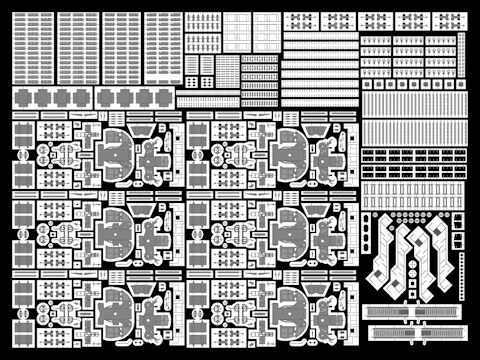In an attempt to further delay the inevitable—that my model might actually reach completion—I designed a new photoetch set. Every time I make a new set I have to change the order of programs for making the masks. I still start in Autocad for its accuracy and ease of us (I find so). However, after having spent many a fine evening with Autocad, pdf-printers and graphical programs, I found myself unable to export the file to a good quality PDF. Circles remain jagged, even when setting the Autocad view setting the maximum, setting the print quality to highest and printing to A0 size. I’ve decided that Autocad is terminally lousy at plotting. Exporting the file (DXF, DWG, all versions Autocad can export) won’t work; the cause is the bad hatch definition in Autocad that other programs as Adobe Illustrator and CorelDraw (latest versions, demo) just won’t accept. I remembered with the previous etch I could directly copy the design to clipboard and insert it into Illustrator. But now I have Windows 7 that runs out of memory while attempting this copying, even though I inserted the full 8 Gbs that my aging PC can handle to avoid exactly that problem. Anyway, away with the hatches and fillings. Reading the lines in Illustrator and filling in all parts, AGAIN, worked.
Here’s the design. I’d love to show you the etched fret. However, the etcher (etchworks) decided that wrapping the etch in crudely shaped cardboard—taped shut leaving all the movement a delicate etch needs to destroy itself while roaming its lush and spacious surroundings—is all the protection you need in the mail. Many parts are now loose, damaged and one or two missing (I did design the lines hold the parts to the fret too thin though). Fortunately I needed only half an A5 and nearly all parts are already etched twice in the fret. If this were a set of railing this would have been a complete failure. Of course, one could ask the etcher to re-etch the design, if this weren’t the second etch already. The first attempt had both top and bottom layers merged on the top of the etch removing all detail and folding lines. The quality of this etch is really good though. I have a few parts designed much smaller than recommended—such as the 0.05mm bars of the sights for the pompoms—and they look wonderful.
The etch itself doesn’t really contain anything new. I removed some design errors from the pompoms and added parts that I wasn’t happy with in the other set. Flag lockers, a few ladders, some parts for the 4″ guns that proved unfoldable (yes, I tried). I also added a selection of rings (always useful), scuppers (overscale, no doubt) and some pulleys, mainly for the funnels. I have a set of custom-made barrels on order from Master in Poland to finish these small pompoms.


